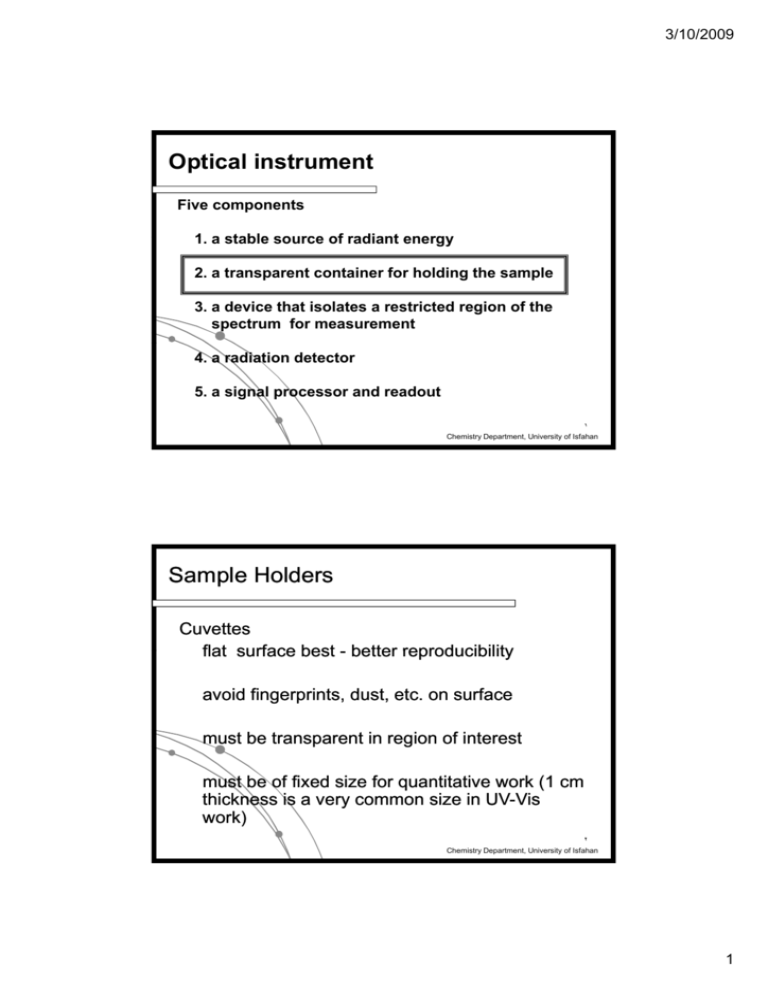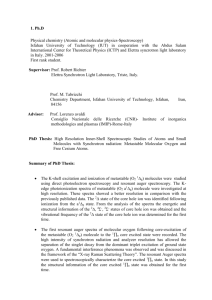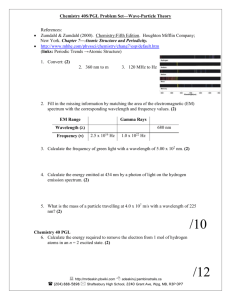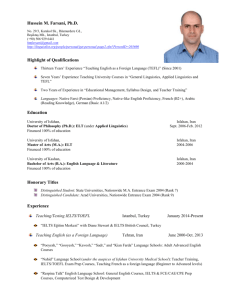Optical instrument Sample Holders
advertisement

3/10/2009 Optical instrument Five components 1 a stable so 1. source rce of radiant energ energy 2. a transparent container for holding the sample 3. a device that isolates a restricted region of the spectrum for measurement 4. a radiation detector 5. a signal processor and readout ١ Chemistry Department, University of Isfahan Sample Holders Cuvettes flat surface best - better reproducibility avoid fingerprints, dust, etc. on surface must be transparent in region of interest must be of fixed size for quantitative work (1 (1 cm thickness is a very common size in UVUV-Vis work) ٢ Chemistry Department, University of Isfahan 1 3/10/2009 Sample Holders (Cuvettes) Cell Materials UV – quartz, fused silica Visible - glass, plastic (UV cells can be used) IR – NaCl, KBr Material quartz q nm range Glass Plastics Polystyrene Methacrylate 150-3000 150375375-2000 360360-800 280 280--800 ٣ Chemistry Department, University of Isfahan Transparent Sample Container Reflection: I r (n 2 − n 1 ) 2 = I 0 (n 2 + n 1 ) 2 ٤ Chemistry Department, University of Isfahan 2 3/10/2009 Construction Materials λ, nm 100 200 VAC 400 UV 700 1000 VIS 2000 4000 7000 10,000 20,000 Near IR IR 40,000 Far IR Spectral region Materials For cells, Windows, Lenses, and prisms LiF Fused silica or quartz Corex glass Silicate glass NaCl KBr TlBr-TlI ZnSe ٥ Chemistry Department, University of Isfahan ٦ 3 3/10/2009 UV-Vis Sample Cells (Cuvettes) ٧ Chemistry Department, University of Isfahan Chemistry Department, University of Isfahan UV-Vis Sample Cells (Cuvettes) ٨ 4 3/10/2009 Optical instrument Five components 1 a stable so 1. source rce of radiant energ energy 2. a transparent container for holding the sample 3. a device that isolates a restricted region of the spectrum for measurement 4. a radiation detector 5. a signal processor and readout ٩ Chemistry Department, University of Isfahan wavelength selectors for spectroscopic instruments. λ, nm 100 200 VAC 400 UV 700 1000 VIS 2000 4000 7000 10,000 20,000 Near IR IR 40,000 Far IR Spectral region Wavelength selectos Fluorite Fused silica or quartz prism Glass prism NaCl prism Continuous KBr prism 3000 lines/mm Grating with various number of lines/mm 50 lines/mm Interference wedges Discontinuous Interference filters Glass absorption filters ١٠ Chemistry Department, University of Isfahan 5 3/10/2009 Output of a typical wavelength selector 100 Nominal wavelength Transmittance, % % Transmittance Effective bandwidth 50 ½ Peak height 0 Wavelength ١١ Chemistry Department, University of Isfahan Optical filters Bandpass filters L Long pass filt filters Short pass filters Interference filters ١٢ Chemistry Department, University of Isfahan 6 3/10/2009 Interference filter Transmits light at a specific wavelength, usually 10-20 nm and 1020% peak transmission efficiency White radiation Glass plate Note that the drawing is not to scale and that the three central bands are much Metal film Dielectric film narrower than shown Narrow band of radiation di ti θ 1 2 3 4 5 A 1´ θ 2´ 3´ 4´ 5´ t B ١٣ Chemistry Department, University of Isfahan Interference filter Rely on optical interference to provide relative narrow bands of radiation. nλ′ = 2AB, AB = t / cos (θ), nλ′ = 2t/cos (θ) (θ approaches zero) nλ′ = 2t λ′ = The wavelength in the medium, λ = ηλ′ η = refractive index of the medium The wavelength of radiation transmitted by the filter are: η/n ((n is the order of interference)) λ´= 2t/n,, λ = 2tη • Interference filters: ultraviolet to about 14 µm in the infrared • typically, effective bandwidths are about 1.5% of the Chemistry Department, University of Isfahan wavelength at peak transmittances. ١٤ 7 3/10/2009 Interference filter Transmission characteristics of typical interference filters Chemistry Department, University of Isfahan ١٥ Interference filter (Wedges) Transmits light of different wavelengths, depending on the thickness of the filter subjected to the incident radistion. The length of the filter ranges g from 50 to 200 mm. Dielectric film Glass plate White radiation The radiation transmitted varies continuously from one ened to the other Metal film Note that the drawing is not to scale and that the three central bands are much narrower than shown Narrow band of radiation di ti ١٦ Chemistry Department, University of Isfahan 8 3/10/2009 Absorption filters function by absorbing certain portions of the spectrum, with bandwidths that range from perhaps 30 to 250 nm; This figure compares the effective bandwidths of interference and absorption filters. Chemistry Department, University of Isfahan ١٧ Long pass filter and short pass filters Transmit a relative large range of radiation Transmission a s ss o ((T)) curves of • a 620-nm shortwavelength-pass filter (Cut-off) • a 515-nm longwavelength-pass filter (Cut-on) Chemistry Department, University of Isfahan ١٨ 9 3/10/2009 Band-Pass Filters Transmit a relative large range of radiation ١٩ Chemistry Department, University of Isfahan Absorption filters Comparison of various types of absorption filters for visible radiation. ٢٠ Chemistry Department, University of Isfahan 10 3/10/2009 MONOCHROMATORS used to disperse polychromatic or white light into the various colors or wavelengths. dispersion can be accomplished using two types of dispersing elements: prisms or reflection gratings (At present. mostly diffraction gratings) The performance specifications of a monochromator include the dispersion, the efficiency, and the stray light levels. ٢١ Chemistry Department, University of Isfahan MONOCHROMATORS Major components: Entrance slit Collimating lens Prism or grating that disperses the radiation into its component λ Focusing elements to refocus the image on a focal plane Exit slit that isolates the desired spectral band ¾ Grating monochromators: angular dispersion of the λ results from diffraction, which occurs at the reflective surface; ¾ Prism monochromators: refraction at the two faces results in angular dispersal of the radiation. ٢٢ Chemistry Department, University of Isfahan 11 3/10/2009 Prism Monochromator Bunsen Prism Monochromator ٢٣ Chemistry Department, University of Isfahan Grating Monochromator Czerney-Turner Grating Monochromator ٢٤ Chemistry Department, University of Isfahan 12 3/10/2009 Advantages of Grating Monochromators Wavelength independence of dispersion. Fixed dispersion makes it easy to scan an entire spectrum at constant bandwidth after initial adjustment of slitwidth. Better dispersion for same size of dispersing element element. Can disperse radiation in far UV and infrared regions where absorption prevents use of prisms. ٢٥ Chemistry Department, University of Isfahan Disadvantages of Grating Monochromators ¾ Produce great amounts of stray radiation. ¾ Produce more high-order spectra. ¾ Both of these disadvantages can be minimized with filters. ٢٦ Chemistry Department, University of Isfahan 13 3/10/2009 Wavelength Selectors ¾ Dispersive Devices • separates EMR into individual λ-components General Features: Exit Focal Plane Dispersive El Element t Image Transfer System Entrance Aperture Exit Aperture ٢٧ Chemistry Department, University of Isfahan Dispersion (Terminology) ¾ How do we quantify the spatial separation of g on the exit focal p plane? wavelengths Dispersive Element F θ1 θ2 λ1 λ2 y1 y2 Angular Dispersion: Da = dθ/dλ (property of dispersive element) Linear Dispersion: D = dy/dλ (property of dispersive device) ٢٨ Chemistry Department, University of Isfahan 14 3/10/2009 More Dispersive Terminology If dθ is small, it can be shown that: D = F × Da • • • Sin dθ = dθ = dy/F More commonly, we will use: Reciprocal Linear Dispersion (D-1) = 1/D • -typically around 0.1 - 20 Å/mm in UV/Vis Effective Bandwidth: Δλeff = D-1 × w Slit-width D-1 = 16 Å/mm w = 100 μm Δλeff = 1.6 Å ٢٩ Chemistry Department, University of Isfahan Prism As we saw in the previous chapter, refraction of light is given by Snell's law: n1 sin θ1 = n2 sin θ2 A prism is a transparent optic that is shaped to bend light. Since the refractive index of a material varies with wavelength, prisms are useful for dispersing different wavelengths of light. Chemistry Department, University of Isfahan ٣٠ 15 3/10/2009 Dispersion of white light by a prism Incident White light Dispersed light ٣١ Chemistry Department, University of Isfahan Dispersion by a prism (a) quartz Cornu types and (b) Littrow type ٣٢ Chemistry Department, University of Isfahan 16 3/10/2009 ٣٣ Rainbow ٣٤ Chemistry Department, University of Isfahan 17 3/10/2009 Diffraction Gratings Typically, a series of closely spaced facets ruled g surface onto a reflecting • Spacing of facets must be comparable to λ of EMR • Parallel EMR rays striking adjacent facets will travel • • different distances Constructive interference occurs if the difference in the distance travelled by the two rays is an integer multiple l i l off λs λ Constructive interference will be a function of the angles (incident and reflection) and the wavelength ٣٥ Chemistry Department, University of Isfahan 18







